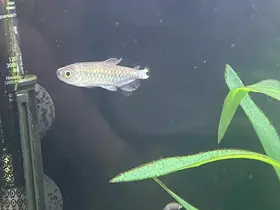Fin Rot
Fin rot is most commonly noted to be related to fin nipping by other fish, however, it is a bacterial infection showing poor water quality. If the coloration of the fin rot is appearing to be white with the fin rotting more evenly than randomly, then it is actually related to the fungal infection compared to the bacterial infection. Although this is a problem that is seen more when fish are housed outside of their natural environment, it can be and is seen within wild populations of fish in their natural waters.
Identification
Fin rot is a symptom that can be noticed almost right away due to the fins being one of the most looked at parts of any fish. The fins can range from a variety of designs, however, they will all share the same signs if the fish is infected with this bacteria. Depending on the fish the fins will start to turn black or brown at the edges, the fins will start to fray, the fin may appear to be falling off, the fins will start to appear red, fins will start to fall apart (pieces will be missing every day), and at the worse case, the whole fin will be missing. Based on how many decorations are made, many owners will start to blame the fact that the fish may have hit the decoration wrong and that is why the fish is missing its fin (or it's damaged).
Another common thought for the fish's fins being damaged is due to the filter's intake tube since many filter intake tubes are not covered by any sort of pre-filter sponge or material and fish tend to drift when they go to sleep during the nighttime. When you first spot any fish that has any damage to its fins, we suggest that you try to cover up the intake tube of your filter(s) and also make sure that no decorations inside could cause any damage to any fish's fins. If these steps are already done and it is neither of these is the cause, then the fish might be infected by this bacteria.
Pathology
Fin rot can be caused by a variety of factors that can either be related to the water parameters, to others that might be caused by nature itself. Since fin rot is a bacterial infection and not a disease, any time that a fish has its fins attacked, pulled, or ripped this can lead to the fins surrounding the damaged ones becoming infected. The most common cause will be housing two different species that do not mix (examples would be having a fast-moving fish which are common fin nippers with slow fish). Many times this cause is dismissed since the fish store states that they are peaceful towards other tank mates but like anything bred in the wild or the aquarium we need to keep in mind that every fish will have its temperament. As always, we suggest that you read various articles on the species of fish that you want to keep to make sure that they can co-exist peacefully with any other tank mates you plan to add. Other times fish may start to nip at each other's fins if the aquarium or pond is overcrowding leading to the strongest fish trying to eliminate the weaker fish. The same can be said if a weekly feeding schedule is not maintained, as the more powerful or dominant fish that are hungry will try to eat the other peaceful fish that may be the same size or even smaller.
Water parameters can be another cause for fin rot to start to develop in various fish. If the water parameters are high in toxins (ammonia, nitrites, and/or nitrates) and water changes are not done to remove such toxins, the fish can get infected with these bacteria and start to develop fin rot. Although this is less common, making sure to always remove any decaying matter such as excess food, dead plant matter, dead fish, or invertebrates, and most importantly having control over the nitrogen cycle will make sure that the water parameters never get out of control.
Treatment and Medication
Treatment of fin rot can depend mostly on how badly the fish's fins are if they are infected if they start to clamp all of their fins closer to their body (known as Clamped Fins), or if there are just a few rips here and there. If the fish's fins are only slightly damaged then doing a big water change of around 50% and maintaining the water parameters throughout can lead to the fish recovering on its own. If the fish's fins are badly damaged, infected, or worse we suggest using medicine to treat fin rot. Medicines that work the best include but are not limited to Maracyn, MelaFix, PrimaFix, Methylene Blue, and other anti-bacterial medicines. When using any medicine, it is recommended to remove any carbon from the filter media and to turn off any UV sterilizers or protein skimmers during usage. It is recommended to remove all decorations in the tank before using methylene blue as it can stain them a slight shade of blue throughout the treatment and if you have any sensitive species within your aquarium please use these medicines at roughly half strength. We recommend following the product's instructions on the bottle when using either of these products.


